Procurement Strategies and Supplier Relationship Management Report
VerifiedAdded on 2022/12/27
|17
|4015
|27
Report
AI Summary
This report delves into the critical aspects of Supplier Relationship Management (SRM) and strategic procurement. It examines the significance of managing supply systems to ensure timely and quality material delivery. The report provides an in-depth analysis of global supply chains, highlighting supply chain functions, factors affecting procurement, and risks associated with international trade, using a case study of a UK food importer from Greece. It explores strategic procurement processes, SRM strategies, and the importance of fostering mutually beneficial relationships with suppliers. The report further discusses risk mitigation strategies, emphasizing the need for proactive management in complex global supply chains, and concludes with recommendations for effective SRM practices. This report emphasizes the importance of a structured approach to procurement, including analysis, planning, communication, and execution, to foster strong supplier relationships and mitigate supply chain risks. The report also provides insight into forming effective supplier relationships, steps for global procurement function risk mitigation, and the importance of collaboration within the industry.
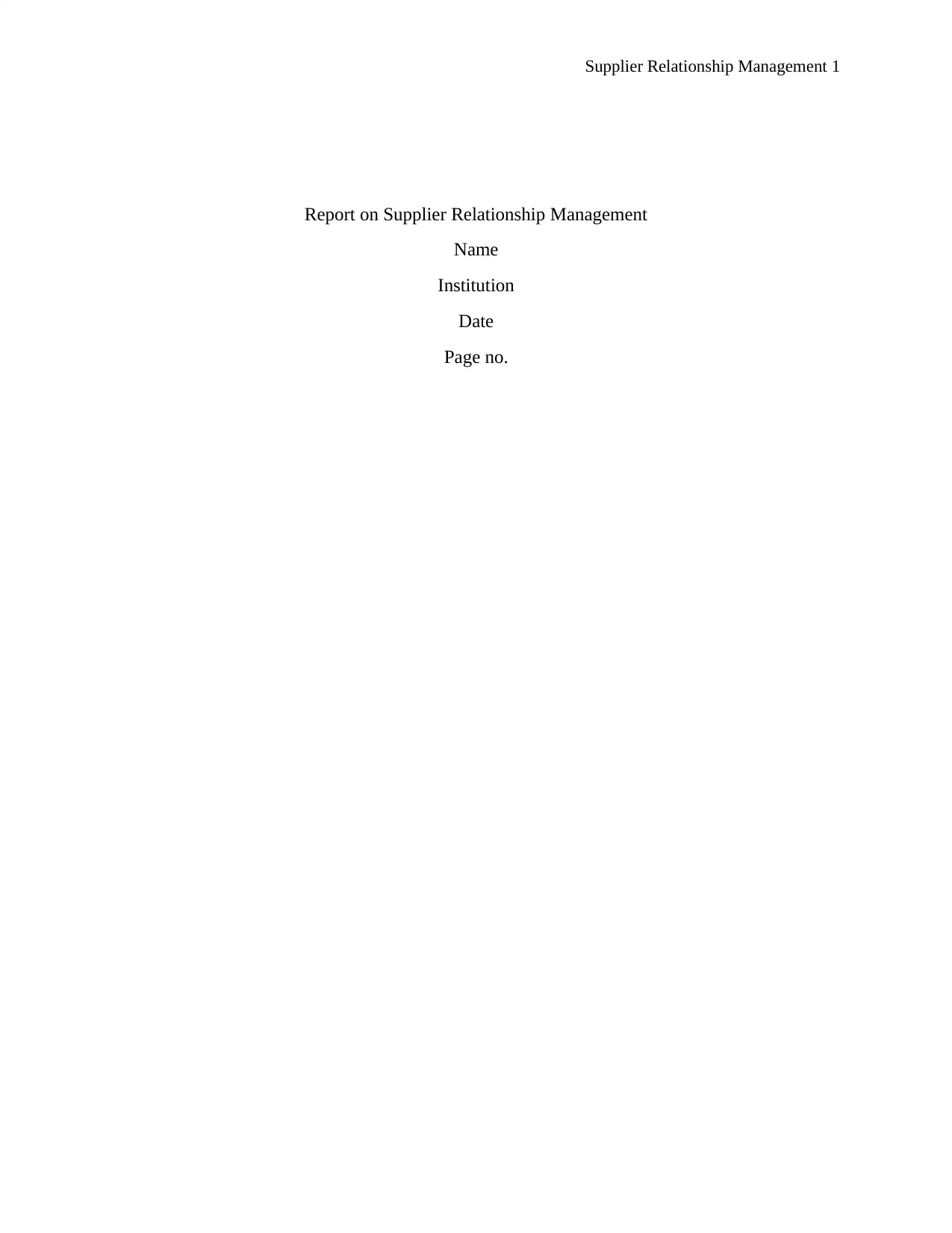
Supplier Relationship Management 1
Report on Supplier Relationship Management
Name
Institution
Date
Page no.
Report on Supplier Relationship Management
Name
Institution
Date
Page no.
Paraphrase This Document
Need a fresh take? Get an instant paraphrase of this document with our AI Paraphraser
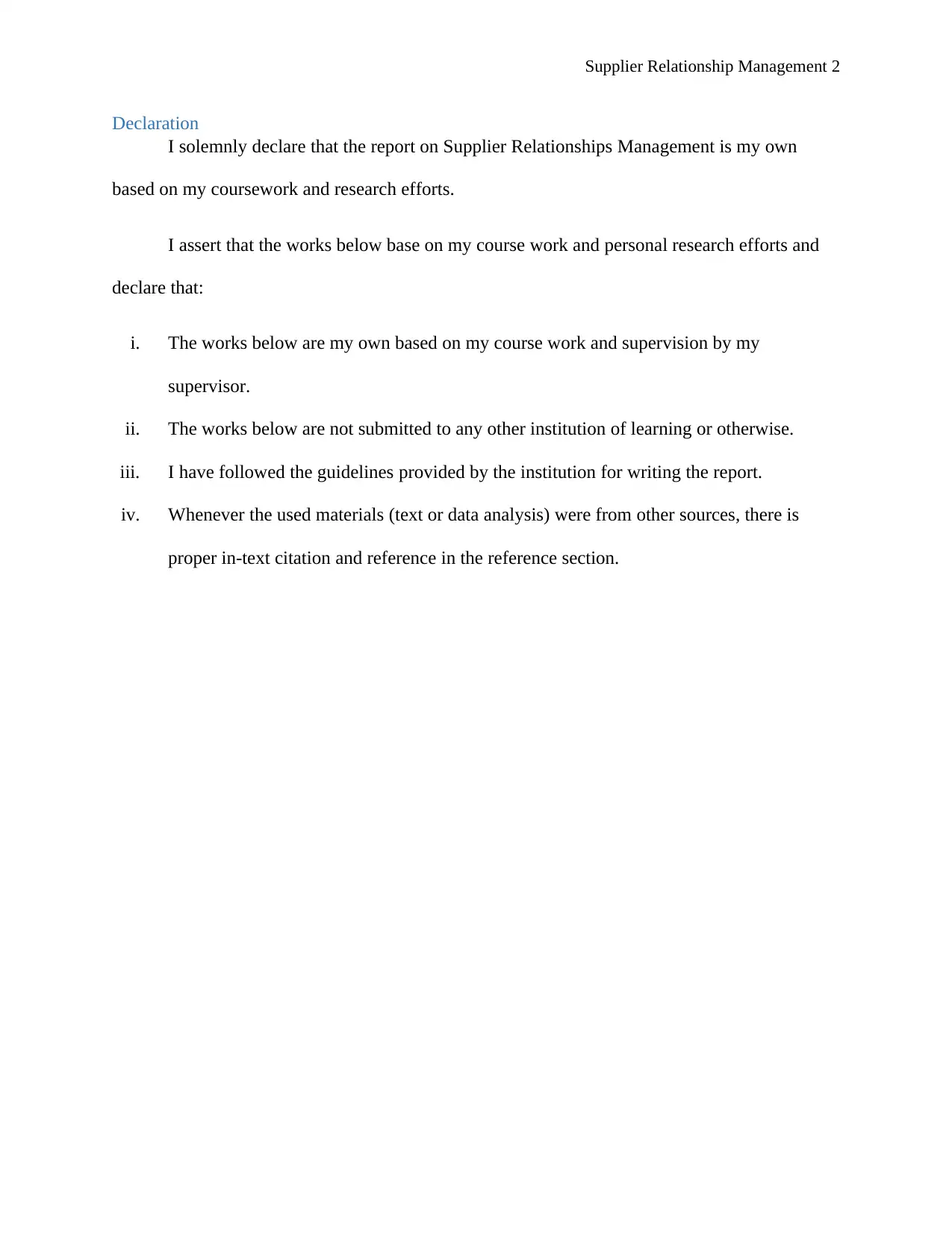
Supplier Relationship Management 2
Declaration
I solemnly declare that the report on Supplier Relationships Management is my own
based on my coursework and research efforts.
I assert that the works below base on my course work and personal research efforts and
declare that:
i. The works below are my own based on my course work and supervision by my
supervisor.
ii. The works below are not submitted to any other institution of learning or otherwise.
iii. I have followed the guidelines provided by the institution for writing the report.
iv. Whenever the used materials (text or data analysis) were from other sources, there is
proper in-text citation and reference in the reference section.
Declaration
I solemnly declare that the report on Supplier Relationships Management is my own
based on my coursework and research efforts.
I assert that the works below base on my course work and personal research efforts and
declare that:
i. The works below are my own based on my course work and supervision by my
supervisor.
ii. The works below are not submitted to any other institution of learning or otherwise.
iii. I have followed the guidelines provided by the institution for writing the report.
iv. Whenever the used materials (text or data analysis) were from other sources, there is
proper in-text citation and reference in the reference section.
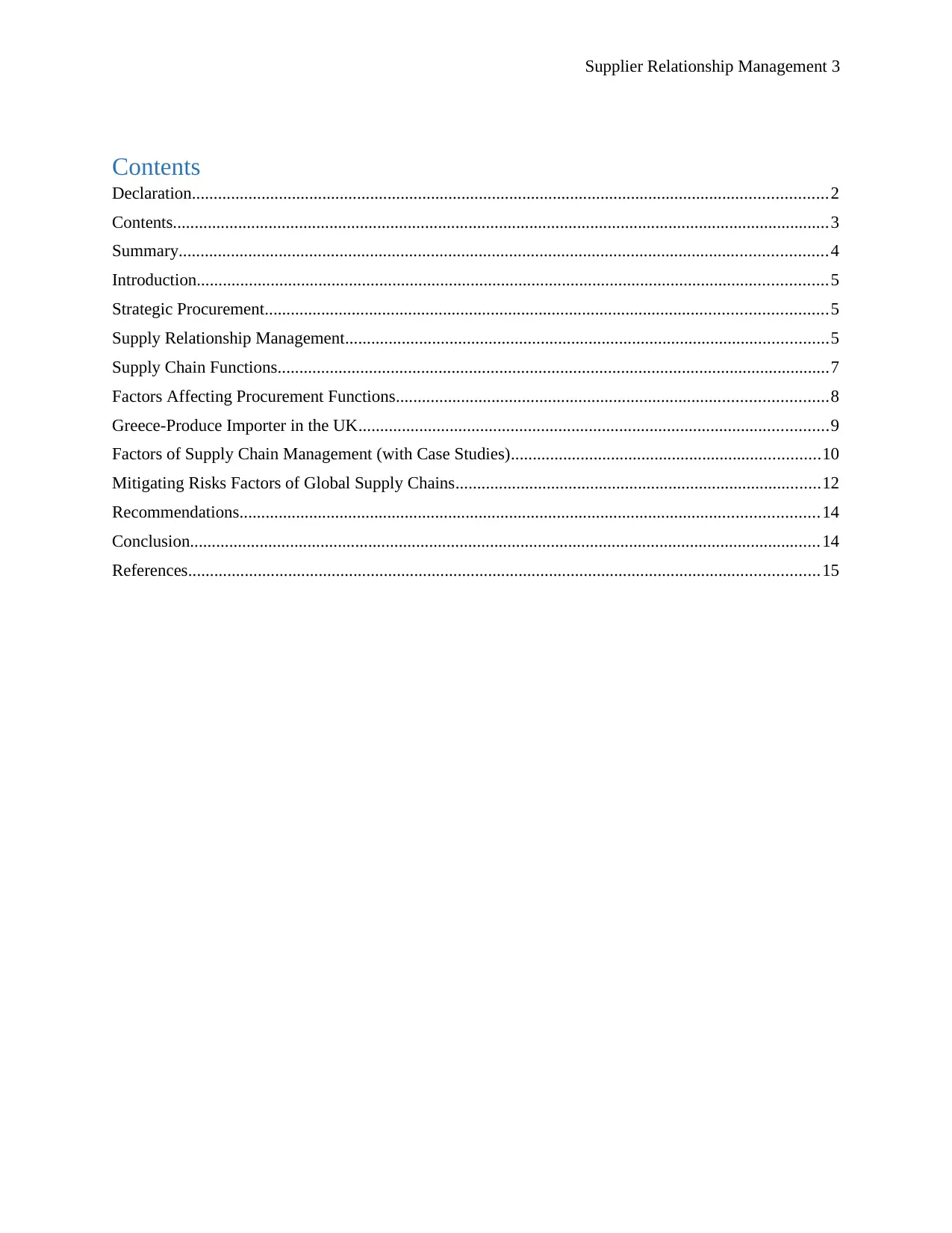
Supplier Relationship Management 3
Contents
Declaration..................................................................................................................................................2
Contents.......................................................................................................................................................3
Summary.....................................................................................................................................................4
Introduction.................................................................................................................................................5
Strategic Procurement.................................................................................................................................5
Supply Relationship Management...............................................................................................................5
Supply Chain Functions...............................................................................................................................7
Factors Affecting Procurement Functions...................................................................................................8
Greece-Produce Importer in the UK............................................................................................................9
Factors of Supply Chain Management (with Case Studies).......................................................................10
Mitigating Risks Factors of Global Supply Chains....................................................................................12
Recommendations.....................................................................................................................................14
Conclusion.................................................................................................................................................14
References.................................................................................................................................................15
Contents
Declaration..................................................................................................................................................2
Contents.......................................................................................................................................................3
Summary.....................................................................................................................................................4
Introduction.................................................................................................................................................5
Strategic Procurement.................................................................................................................................5
Supply Relationship Management...............................................................................................................5
Supply Chain Functions...............................................................................................................................7
Factors Affecting Procurement Functions...................................................................................................8
Greece-Produce Importer in the UK............................................................................................................9
Factors of Supply Chain Management (with Case Studies).......................................................................10
Mitigating Risks Factors of Global Supply Chains....................................................................................12
Recommendations.....................................................................................................................................14
Conclusion.................................................................................................................................................14
References.................................................................................................................................................15
⊘ This is a preview!⊘
Do you want full access?
Subscribe today to unlock all pages.

Trusted by 1+ million students worldwide
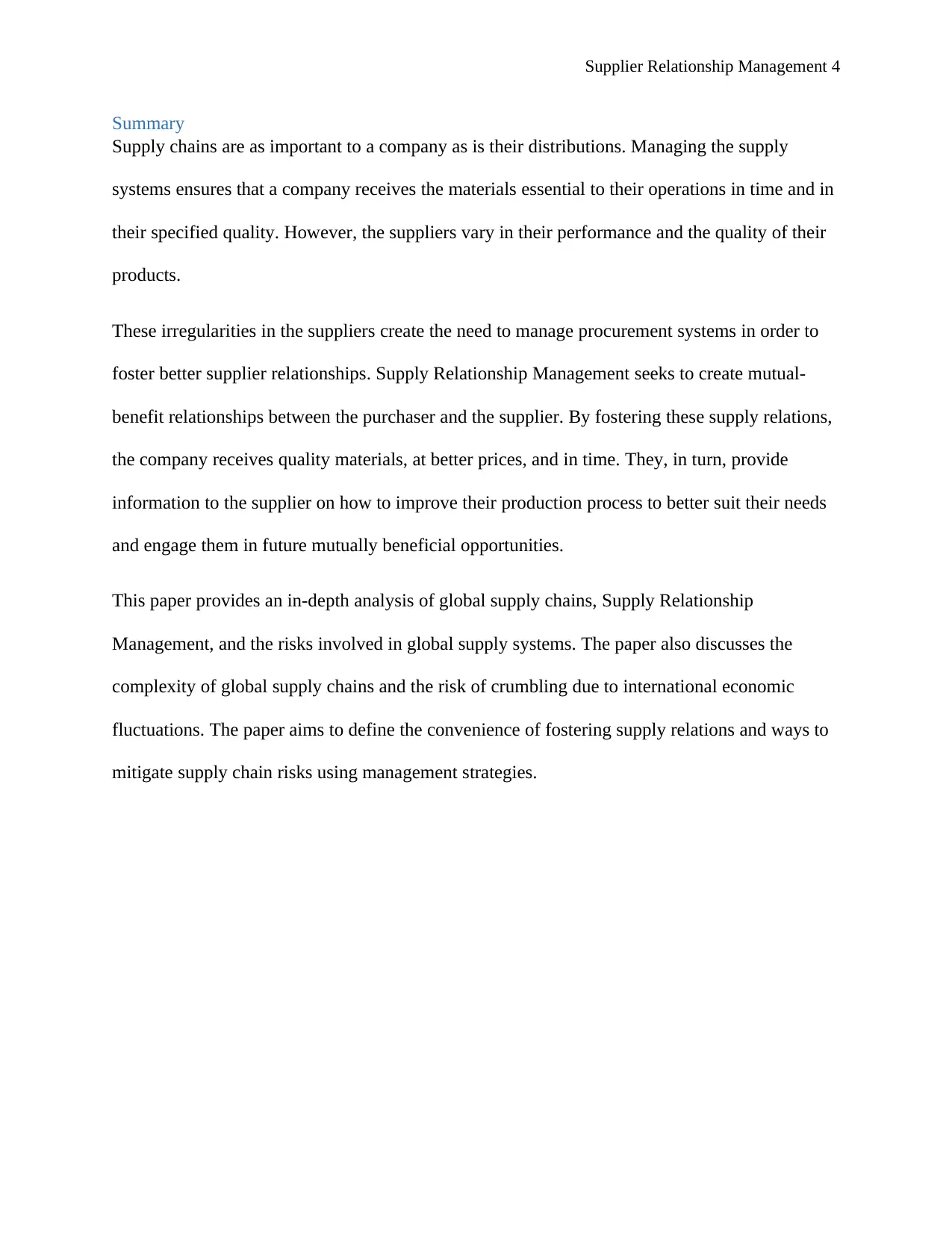
Supplier Relationship Management 4
Summary
Supply chains are as important to a company as is their distributions. Managing the supply
systems ensures that a company receives the materials essential to their operations in time and in
their specified quality. However, the suppliers vary in their performance and the quality of their
products.
These irregularities in the suppliers create the need to manage procurement systems in order to
foster better supplier relationships. Supply Relationship Management seeks to create mutual-
benefit relationships between the purchaser and the supplier. By fostering these supply relations,
the company receives quality materials, at better prices, and in time. They, in turn, provide
information to the supplier on how to improve their production process to better suit their needs
and engage them in future mutually beneficial opportunities.
This paper provides an in-depth analysis of global supply chains, Supply Relationship
Management, and the risks involved in global supply systems. The paper also discusses the
complexity of global supply chains and the risk of crumbling due to international economic
fluctuations. The paper aims to define the convenience of fostering supply relations and ways to
mitigate supply chain risks using management strategies.
Summary
Supply chains are as important to a company as is their distributions. Managing the supply
systems ensures that a company receives the materials essential to their operations in time and in
their specified quality. However, the suppliers vary in their performance and the quality of their
products.
These irregularities in the suppliers create the need to manage procurement systems in order to
foster better supplier relationships. Supply Relationship Management seeks to create mutual-
benefit relationships between the purchaser and the supplier. By fostering these supply relations,
the company receives quality materials, at better prices, and in time. They, in turn, provide
information to the supplier on how to improve their production process to better suit their needs
and engage them in future mutually beneficial opportunities.
This paper provides an in-depth analysis of global supply chains, Supply Relationship
Management, and the risks involved in global supply systems. The paper also discusses the
complexity of global supply chains and the risk of crumbling due to international economic
fluctuations. The paper aims to define the convenience of fostering supply relations and ways to
mitigate supply chain risks using management strategies.
Paraphrase This Document
Need a fresh take? Get an instant paraphrase of this document with our AI Paraphraser
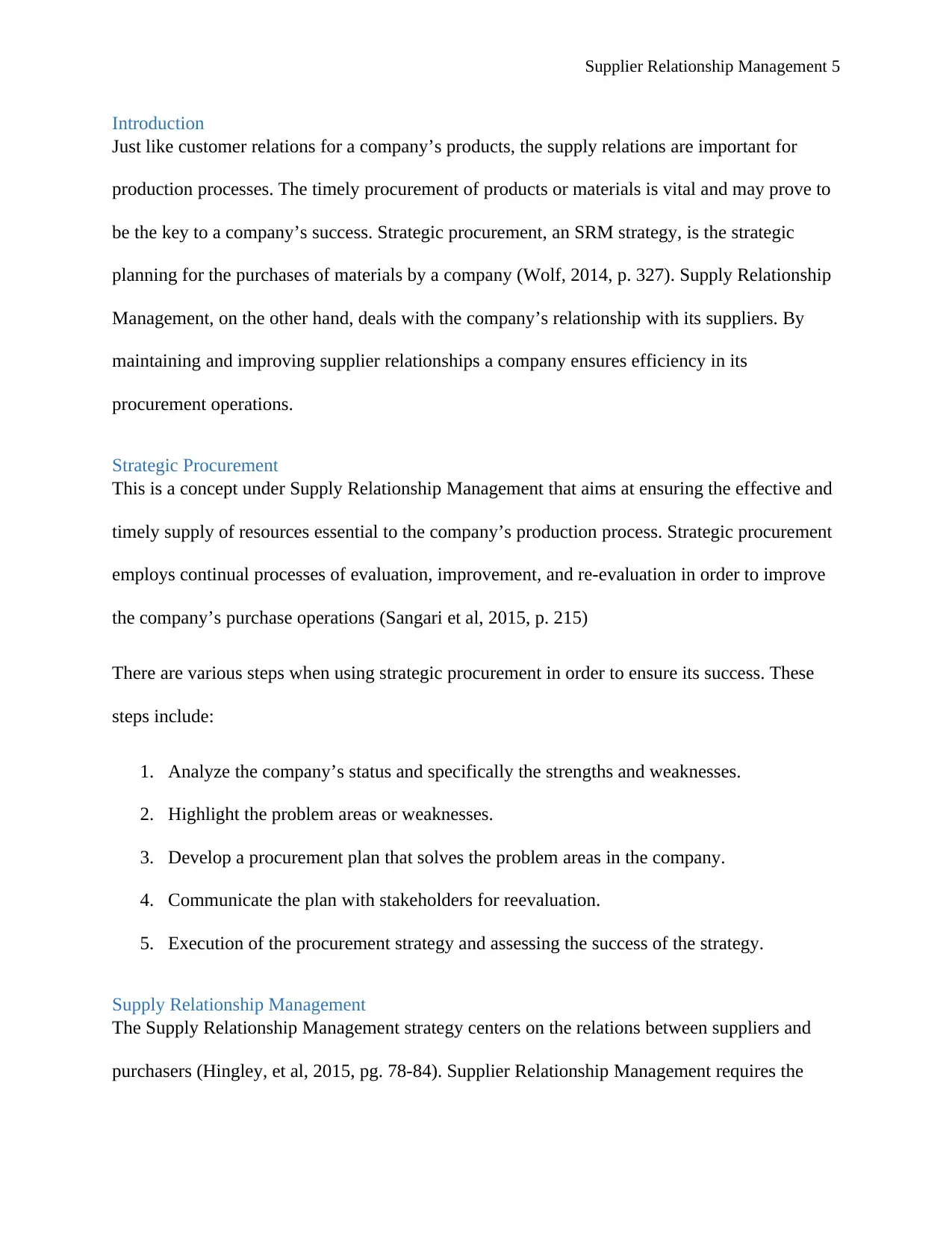
Supplier Relationship Management 5
Introduction
Just like customer relations for a company’s products, the supply relations are important for
production processes. The timely procurement of products or materials is vital and may prove to
be the key to a company’s success. Strategic procurement, an SRM strategy, is the strategic
planning for the purchases of materials by a company (Wolf, 2014, p. 327). Supply Relationship
Management, on the other hand, deals with the company’s relationship with its suppliers. By
maintaining and improving supplier relationships a company ensures efficiency in its
procurement operations.
Strategic Procurement
This is a concept under Supply Relationship Management that aims at ensuring the effective and
timely supply of resources essential to the company’s production process. Strategic procurement
employs continual processes of evaluation, improvement, and re-evaluation in order to improve
the company’s purchase operations (Sangari et al, 2015, p. 215)
There are various steps when using strategic procurement in order to ensure its success. These
steps include:
1. Analyze the company’s status and specifically the strengths and weaknesses.
2. Highlight the problem areas or weaknesses.
3. Develop a procurement plan that solves the problem areas in the company.
4. Communicate the plan with stakeholders for reevaluation.
5. Execution of the procurement strategy and assessing the success of the strategy.
Supply Relationship Management
The Supply Relationship Management strategy centers on the relations between suppliers and
purchasers (Hingley, et al, 2015, pg. 78-84). Supplier Relationship Management requires the
Introduction
Just like customer relations for a company’s products, the supply relations are important for
production processes. The timely procurement of products or materials is vital and may prove to
be the key to a company’s success. Strategic procurement, an SRM strategy, is the strategic
planning for the purchases of materials by a company (Wolf, 2014, p. 327). Supply Relationship
Management, on the other hand, deals with the company’s relationship with its suppliers. By
maintaining and improving supplier relationships a company ensures efficiency in its
procurement operations.
Strategic Procurement
This is a concept under Supply Relationship Management that aims at ensuring the effective and
timely supply of resources essential to the company’s production process. Strategic procurement
employs continual processes of evaluation, improvement, and re-evaluation in order to improve
the company’s purchase operations (Sangari et al, 2015, p. 215)
There are various steps when using strategic procurement in order to ensure its success. These
steps include:
1. Analyze the company’s status and specifically the strengths and weaknesses.
2. Highlight the problem areas or weaknesses.
3. Develop a procurement plan that solves the problem areas in the company.
4. Communicate the plan with stakeholders for reevaluation.
5. Execution of the procurement strategy and assessing the success of the strategy.
Supply Relationship Management
The Supply Relationship Management strategy centers on the relations between suppliers and
purchasers (Hingley, et al, 2015, pg. 78-84). Supplier Relationship Management requires the
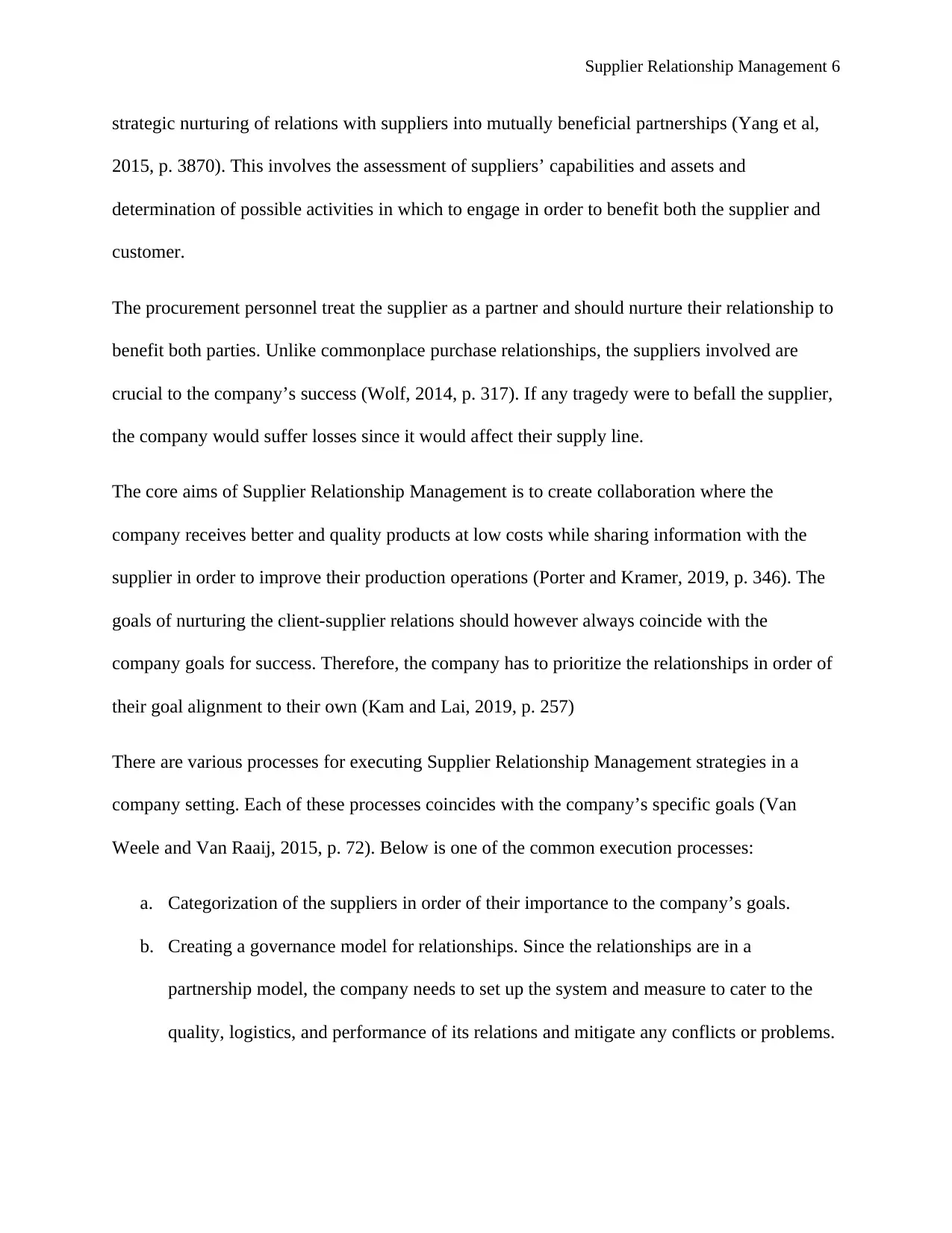
Supplier Relationship Management 6
strategic nurturing of relations with suppliers into mutually beneficial partnerships (Yang et al,
2015, p. 3870). This involves the assessment of suppliers’ capabilities and assets and
determination of possible activities in which to engage in order to benefit both the supplier and
customer.
The procurement personnel treat the supplier as a partner and should nurture their relationship to
benefit both parties. Unlike commonplace purchase relationships, the suppliers involved are
crucial to the company’s success (Wolf, 2014, p. 317). If any tragedy were to befall the supplier,
the company would suffer losses since it would affect their supply line.
The core aims of Supplier Relationship Management is to create collaboration where the
company receives better and quality products at low costs while sharing information with the
supplier in order to improve their production operations (Porter and Kramer, 2019, p. 346). The
goals of nurturing the client-supplier relations should however always coincide with the
company goals for success. Therefore, the company has to prioritize the relationships in order of
their goal alignment to their own (Kam and Lai, 2019, p. 257)
There are various processes for executing Supplier Relationship Management strategies in a
company setting. Each of these processes coincides with the company’s specific goals (Van
Weele and Van Raaij, 2015, p. 72). Below is one of the common execution processes:
a. Categorization of the suppliers in order of their importance to the company’s goals.
b. Creating a governance model for relationships. Since the relationships are in a
partnership model, the company needs to set up the system and measure to cater to the
quality, logistics, and performance of its relations and mitigate any conflicts or problems.
strategic nurturing of relations with suppliers into mutually beneficial partnerships (Yang et al,
2015, p. 3870). This involves the assessment of suppliers’ capabilities and assets and
determination of possible activities in which to engage in order to benefit both the supplier and
customer.
The procurement personnel treat the supplier as a partner and should nurture their relationship to
benefit both parties. Unlike commonplace purchase relationships, the suppliers involved are
crucial to the company’s success (Wolf, 2014, p. 317). If any tragedy were to befall the supplier,
the company would suffer losses since it would affect their supply line.
The core aims of Supplier Relationship Management is to create collaboration where the
company receives better and quality products at low costs while sharing information with the
supplier in order to improve their production operations (Porter and Kramer, 2019, p. 346). The
goals of nurturing the client-supplier relations should however always coincide with the
company goals for success. Therefore, the company has to prioritize the relationships in order of
their goal alignment to their own (Kam and Lai, 2019, p. 257)
There are various processes for executing Supplier Relationship Management strategies in a
company setting. Each of these processes coincides with the company’s specific goals (Van
Weele and Van Raaij, 2015, p. 72). Below is one of the common execution processes:
a. Categorization of the suppliers in order of their importance to the company’s goals.
b. Creating a governance model for relationships. Since the relationships are in a
partnership model, the company needs to set up the system and measure to cater to the
quality, logistics, and performance of its relations and mitigate any conflicts or problems.
⊘ This is a preview!⊘
Do you want full access?
Subscribe today to unlock all pages.

Trusted by 1+ million students worldwide
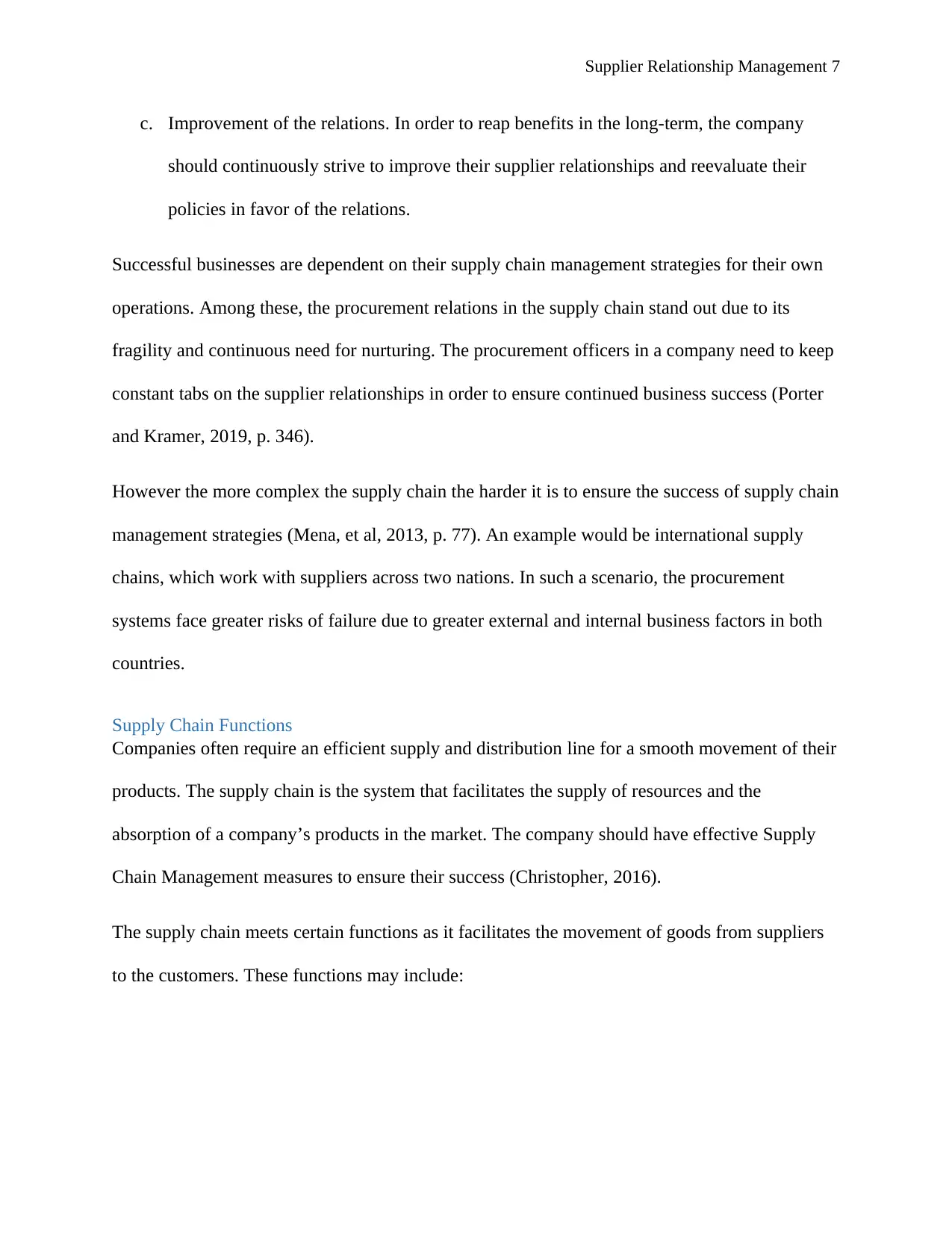
Supplier Relationship Management 7
c. Improvement of the relations. In order to reap benefits in the long-term, the company
should continuously strive to improve their supplier relationships and reevaluate their
policies in favor of the relations.
Successful businesses are dependent on their supply chain management strategies for their own
operations. Among these, the procurement relations in the supply chain stand out due to its
fragility and continuous need for nurturing. The procurement officers in a company need to keep
constant tabs on the supplier relationships in order to ensure continued business success (Porter
and Kramer, 2019, p. 346).
However the more complex the supply chain the harder it is to ensure the success of supply chain
management strategies (Mena, et al, 2013, p. 77). An example would be international supply
chains, which work with suppliers across two nations. In such a scenario, the procurement
systems face greater risks of failure due to greater external and internal business factors in both
countries.
Supply Chain Functions
Companies often require an efficient supply and distribution line for a smooth movement of their
products. The supply chain is the system that facilitates the supply of resources and the
absorption of a company’s products in the market. The company should have effective Supply
Chain Management measures to ensure their success (Christopher, 2016).
The supply chain meets certain functions as it facilitates the movement of goods from suppliers
to the customers. These functions may include:
c. Improvement of the relations. In order to reap benefits in the long-term, the company
should continuously strive to improve their supplier relationships and reevaluate their
policies in favor of the relations.
Successful businesses are dependent on their supply chain management strategies for their own
operations. Among these, the procurement relations in the supply chain stand out due to its
fragility and continuous need for nurturing. The procurement officers in a company need to keep
constant tabs on the supplier relationships in order to ensure continued business success (Porter
and Kramer, 2019, p. 346).
However the more complex the supply chain the harder it is to ensure the success of supply chain
management strategies (Mena, et al, 2013, p. 77). An example would be international supply
chains, which work with suppliers across two nations. In such a scenario, the procurement
systems face greater risks of failure due to greater external and internal business factors in both
countries.
Supply Chain Functions
Companies often require an efficient supply and distribution line for a smooth movement of their
products. The supply chain is the system that facilitates the supply of resources and the
absorption of a company’s products in the market. The company should have effective Supply
Chain Management measures to ensure their success (Christopher, 2016).
The supply chain meets certain functions as it facilitates the movement of goods from suppliers
to the customers. These functions may include:
Paraphrase This Document
Need a fresh take? Get an instant paraphrase of this document with our AI Paraphraser
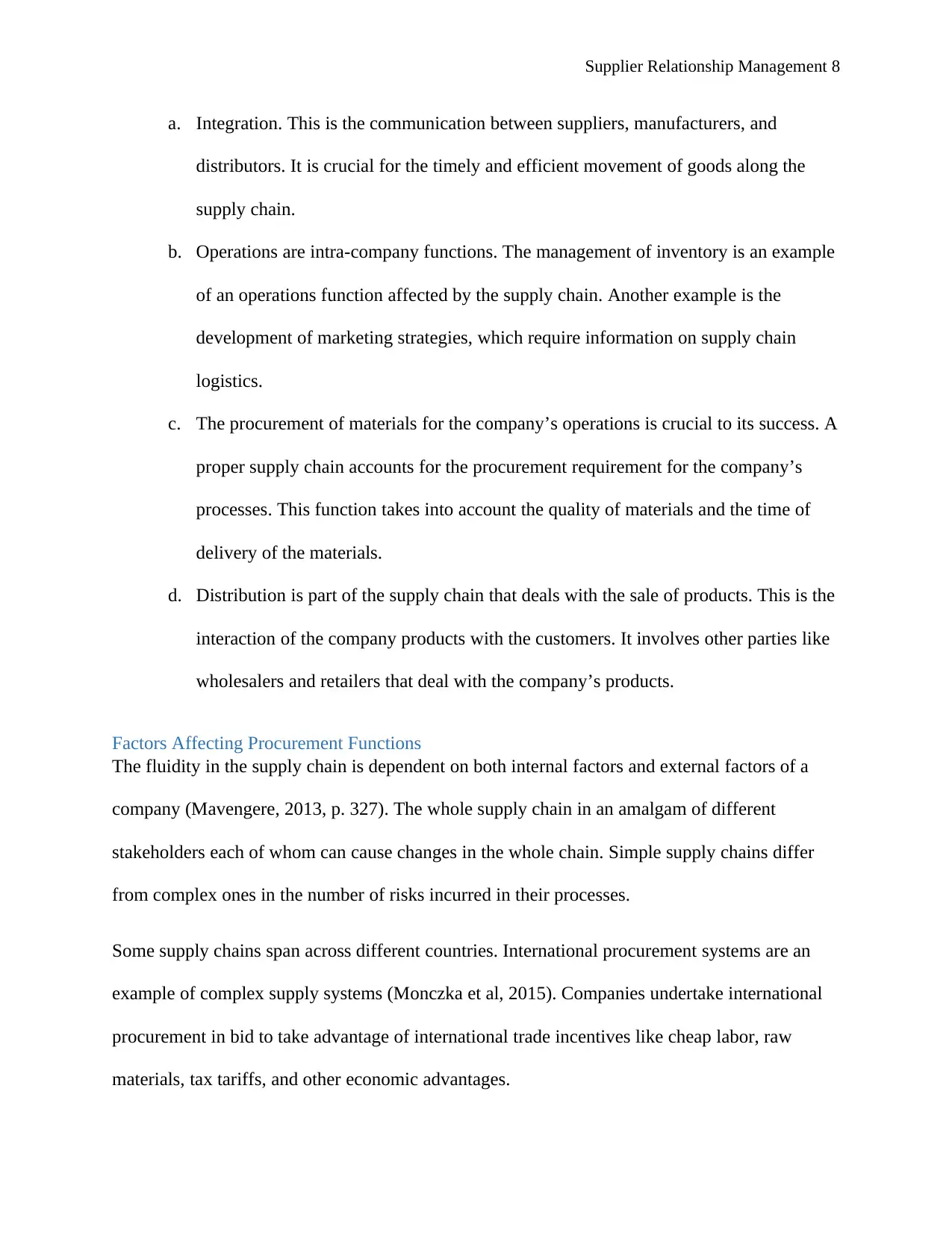
Supplier Relationship Management 8
a. Integration. This is the communication between suppliers, manufacturers, and
distributors. It is crucial for the timely and efficient movement of goods along the
supply chain.
b. Operations are intra-company functions. The management of inventory is an example
of an operations function affected by the supply chain. Another example is the
development of marketing strategies, which require information on supply chain
logistics.
c. The procurement of materials for the company’s operations is crucial to its success. A
proper supply chain accounts for the procurement requirement for the company’s
processes. This function takes into account the quality of materials and the time of
delivery of the materials.
d. Distribution is part of the supply chain that deals with the sale of products. This is the
interaction of the company products with the customers. It involves other parties like
wholesalers and retailers that deal with the company’s products.
Factors Affecting Procurement Functions
The fluidity in the supply chain is dependent on both internal factors and external factors of a
company (Mavengere, 2013, p. 327). The whole supply chain in an amalgam of different
stakeholders each of whom can cause changes in the whole chain. Simple supply chains differ
from complex ones in the number of risks incurred in their processes.
Some supply chains span across different countries. International procurement systems are an
example of complex supply systems (Monczka et al, 2015). Companies undertake international
procurement in bid to take advantage of international trade incentives like cheap labor, raw
materials, tax tariffs, and other economic advantages.
a. Integration. This is the communication between suppliers, manufacturers, and
distributors. It is crucial for the timely and efficient movement of goods along the
supply chain.
b. Operations are intra-company functions. The management of inventory is an example
of an operations function affected by the supply chain. Another example is the
development of marketing strategies, which require information on supply chain
logistics.
c. The procurement of materials for the company’s operations is crucial to its success. A
proper supply chain accounts for the procurement requirement for the company’s
processes. This function takes into account the quality of materials and the time of
delivery of the materials.
d. Distribution is part of the supply chain that deals with the sale of products. This is the
interaction of the company products with the customers. It involves other parties like
wholesalers and retailers that deal with the company’s products.
Factors Affecting Procurement Functions
The fluidity in the supply chain is dependent on both internal factors and external factors of a
company (Mavengere, 2013, p. 327). The whole supply chain in an amalgam of different
stakeholders each of whom can cause changes in the whole chain. Simple supply chains differ
from complex ones in the number of risks incurred in their processes.
Some supply chains span across different countries. International procurement systems are an
example of complex supply systems (Monczka et al, 2015). Companies undertake international
procurement in bid to take advantage of international trade incentives like cheap labor, raw
materials, tax tariffs, and other economic advantages.
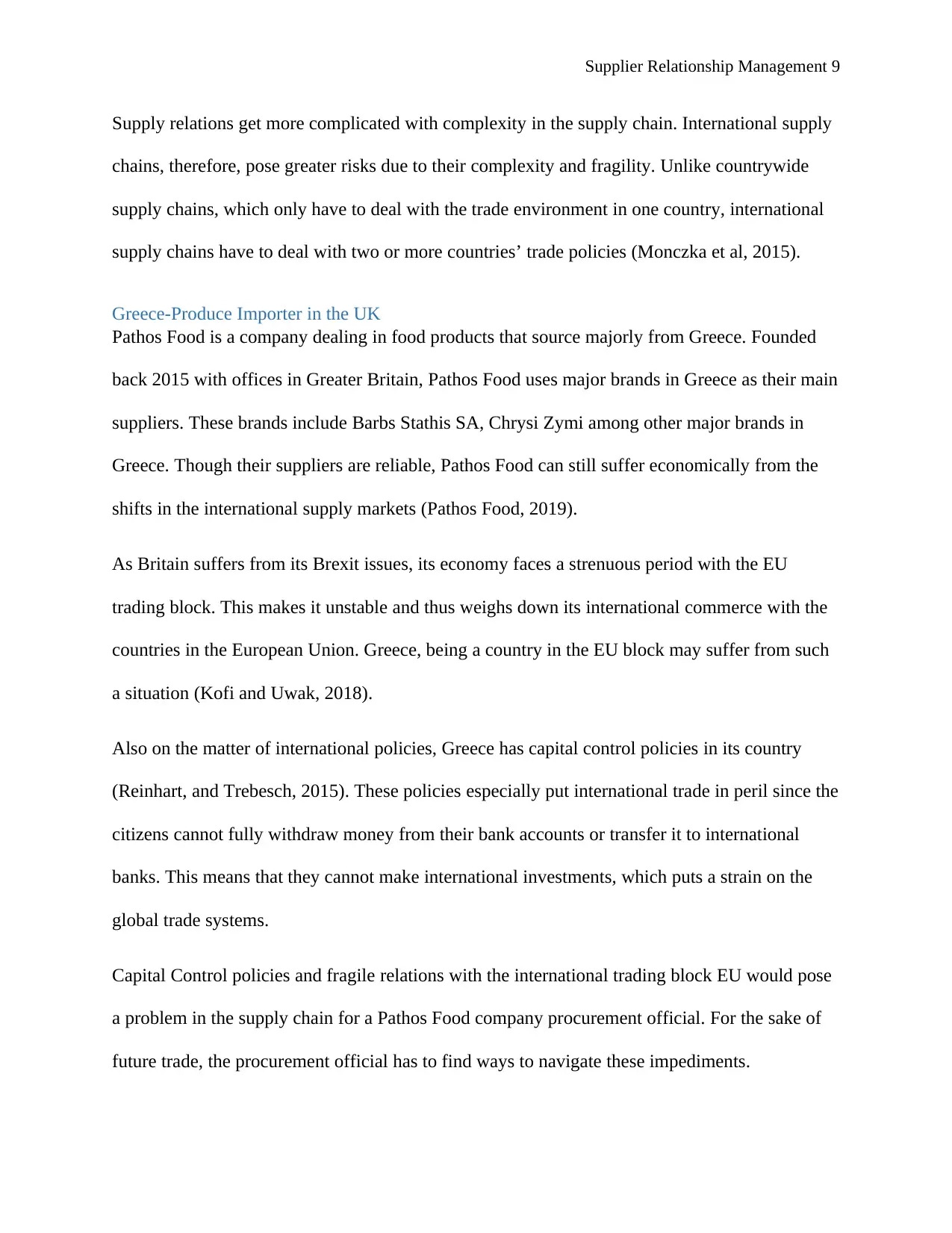
Supplier Relationship Management 9
Supply relations get more complicated with complexity in the supply chain. International supply
chains, therefore, pose greater risks due to their complexity and fragility. Unlike countrywide
supply chains, which only have to deal with the trade environment in one country, international
supply chains have to deal with two or more countries’ trade policies (Monczka et al, 2015).
Greece-Produce Importer in the UK
Pathos Food is a company dealing in food products that source majorly from Greece. Founded
back 2015 with offices in Greater Britain, Pathos Food uses major brands in Greece as their main
suppliers. These brands include Barbs Stathis SA, Chrysi Zymi among other major brands in
Greece. Though their suppliers are reliable, Pathos Food can still suffer economically from the
shifts in the international supply markets (Pathos Food, 2019).
As Britain suffers from its Brexit issues, its economy faces a strenuous period with the EU
trading block. This makes it unstable and thus weighs down its international commerce with the
countries in the European Union. Greece, being a country in the EU block may suffer from such
a situation (Kofi and Uwak, 2018).
Also on the matter of international policies, Greece has capital control policies in its country
(Reinhart, and Trebesch, 2015). These policies especially put international trade in peril since the
citizens cannot fully withdraw money from their bank accounts or transfer it to international
banks. This means that they cannot make international investments, which puts a strain on the
global trade systems.
Capital Control policies and fragile relations with the international trading block EU would pose
a problem in the supply chain for a Pathos Food company procurement official. For the sake of
future trade, the procurement official has to find ways to navigate these impediments.
Supply relations get more complicated with complexity in the supply chain. International supply
chains, therefore, pose greater risks due to their complexity and fragility. Unlike countrywide
supply chains, which only have to deal with the trade environment in one country, international
supply chains have to deal with two or more countries’ trade policies (Monczka et al, 2015).
Greece-Produce Importer in the UK
Pathos Food is a company dealing in food products that source majorly from Greece. Founded
back 2015 with offices in Greater Britain, Pathos Food uses major brands in Greece as their main
suppliers. These brands include Barbs Stathis SA, Chrysi Zymi among other major brands in
Greece. Though their suppliers are reliable, Pathos Food can still suffer economically from the
shifts in the international supply markets (Pathos Food, 2019).
As Britain suffers from its Brexit issues, its economy faces a strenuous period with the EU
trading block. This makes it unstable and thus weighs down its international commerce with the
countries in the European Union. Greece, being a country in the EU block may suffer from such
a situation (Kofi and Uwak, 2018).
Also on the matter of international policies, Greece has capital control policies in its country
(Reinhart, and Trebesch, 2015). These policies especially put international trade in peril since the
citizens cannot fully withdraw money from their bank accounts or transfer it to international
banks. This means that they cannot make international investments, which puts a strain on the
global trade systems.
Capital Control policies and fragile relations with the international trading block EU would pose
a problem in the supply chain for a Pathos Food company procurement official. For the sake of
future trade, the procurement official has to find ways to navigate these impediments.
⊘ This is a preview!⊘
Do you want full access?
Subscribe today to unlock all pages.

Trusted by 1+ million students worldwide
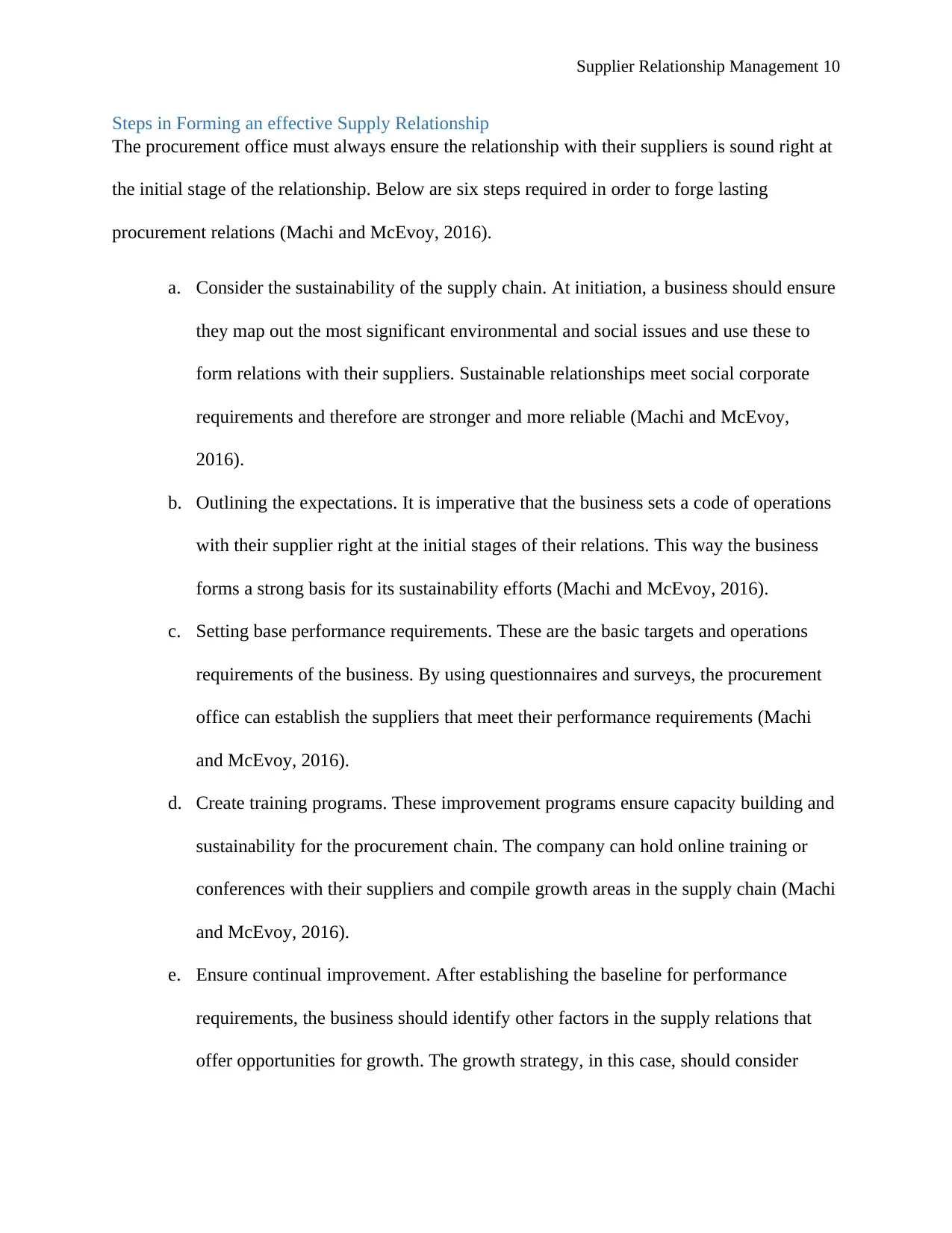
Supplier Relationship Management 10
Steps in Forming an effective Supply Relationship
The procurement office must always ensure the relationship with their suppliers is sound right at
the initial stage of the relationship. Below are six steps required in order to forge lasting
procurement relations (Machi and McEvoy, 2016).
a. Consider the sustainability of the supply chain. At initiation, a business should ensure
they map out the most significant environmental and social issues and use these to
form relations with their suppliers. Sustainable relationships meet social corporate
requirements and therefore are stronger and more reliable (Machi and McEvoy,
2016).
b. Outlining the expectations. It is imperative that the business sets a code of operations
with their supplier right at the initial stages of their relations. This way the business
forms a strong basis for its sustainability efforts (Machi and McEvoy, 2016).
c. Setting base performance requirements. These are the basic targets and operations
requirements of the business. By using questionnaires and surveys, the procurement
office can establish the suppliers that meet their performance requirements (Machi
and McEvoy, 2016).
d. Create training programs. These improvement programs ensure capacity building and
sustainability for the procurement chain. The company can hold online training or
conferences with their suppliers and compile growth areas in the supply chain (Machi
and McEvoy, 2016).
e. Ensure continual improvement. After establishing the baseline for performance
requirements, the business should identify other factors in the supply relations that
offer opportunities for growth. The growth strategy, in this case, should consider
Steps in Forming an effective Supply Relationship
The procurement office must always ensure the relationship with their suppliers is sound right at
the initial stage of the relationship. Below are six steps required in order to forge lasting
procurement relations (Machi and McEvoy, 2016).
a. Consider the sustainability of the supply chain. At initiation, a business should ensure
they map out the most significant environmental and social issues and use these to
form relations with their suppliers. Sustainable relationships meet social corporate
requirements and therefore are stronger and more reliable (Machi and McEvoy,
2016).
b. Outlining the expectations. It is imperative that the business sets a code of operations
with their supplier right at the initial stages of their relations. This way the business
forms a strong basis for its sustainability efforts (Machi and McEvoy, 2016).
c. Setting base performance requirements. These are the basic targets and operations
requirements of the business. By using questionnaires and surveys, the procurement
office can establish the suppliers that meet their performance requirements (Machi
and McEvoy, 2016).
d. Create training programs. These improvement programs ensure capacity building and
sustainability for the procurement chain. The company can hold online training or
conferences with their suppliers and compile growth areas in the supply chain (Machi
and McEvoy, 2016).
e. Ensure continual improvement. After establishing the baseline for performance
requirements, the business should identify other factors in the supply relations that
offer opportunities for growth. The growth strategy, in this case, should consider
Paraphrase This Document
Need a fresh take? Get an instant paraphrase of this document with our AI Paraphraser
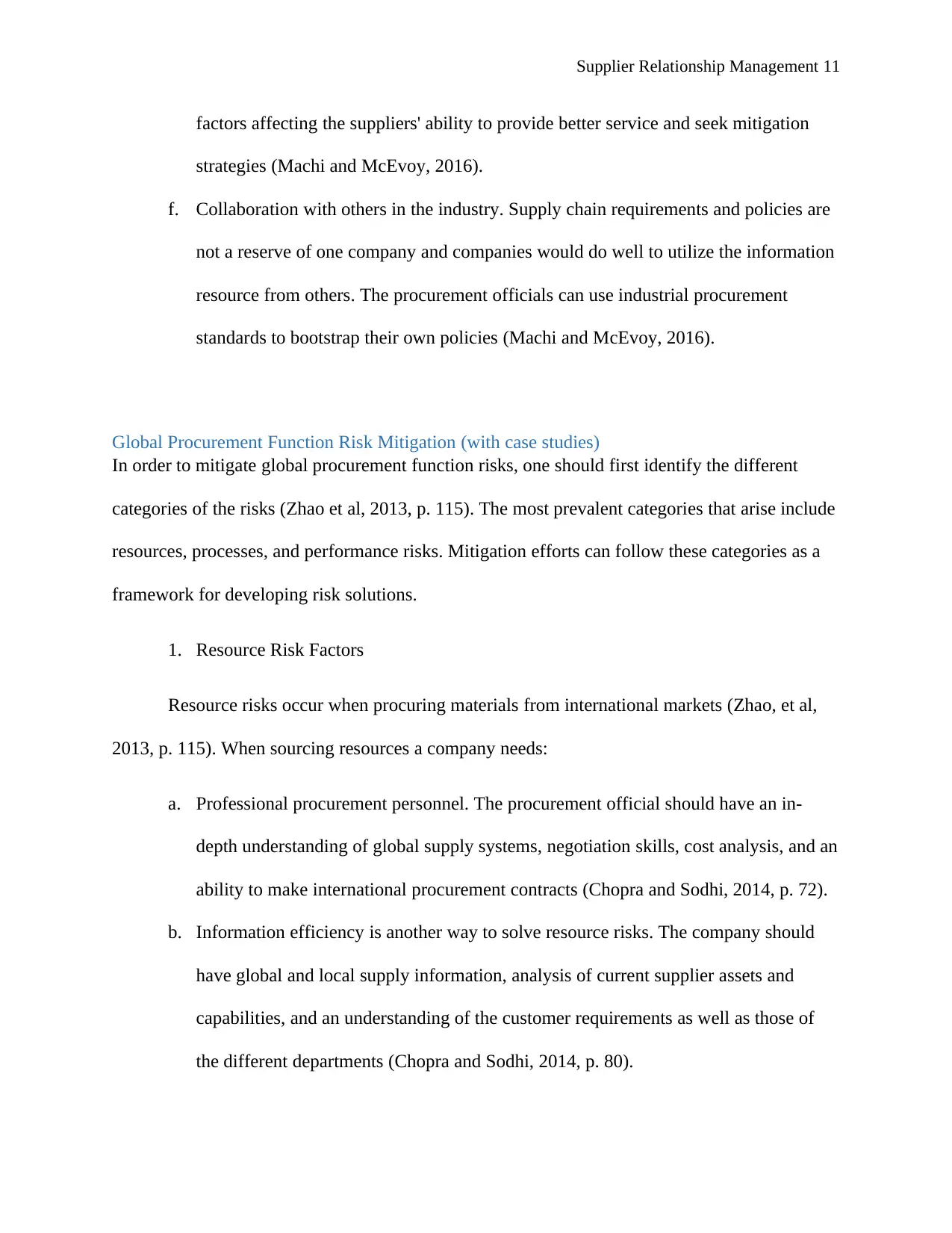
Supplier Relationship Management 11
factors affecting the suppliers' ability to provide better service and seek mitigation
strategies (Machi and McEvoy, 2016).
f. Collaboration with others in the industry. Supply chain requirements and policies are
not a reserve of one company and companies would do well to utilize the information
resource from others. The procurement officials can use industrial procurement
standards to bootstrap their own policies (Machi and McEvoy, 2016).
Global Procurement Function Risk Mitigation (with case studies)
In order to mitigate global procurement function risks, one should first identify the different
categories of the risks (Zhao et al, 2013, p. 115). The most prevalent categories that arise include
resources, processes, and performance risks. Mitigation efforts can follow these categories as a
framework for developing risk solutions.
1. Resource Risk Factors
Resource risks occur when procuring materials from international markets (Zhao, et al,
2013, p. 115). When sourcing resources a company needs:
a. Professional procurement personnel. The procurement official should have an in-
depth understanding of global supply systems, negotiation skills, cost analysis, and an
ability to make international procurement contracts (Chopra and Sodhi, 2014, p. 72).
b. Information efficiency is another way to solve resource risks. The company should
have global and local supply information, analysis of current supplier assets and
capabilities, and an understanding of the customer requirements as well as those of
the different departments (Chopra and Sodhi, 2014, p. 80).
factors affecting the suppliers' ability to provide better service and seek mitigation
strategies (Machi and McEvoy, 2016).
f. Collaboration with others in the industry. Supply chain requirements and policies are
not a reserve of one company and companies would do well to utilize the information
resource from others. The procurement officials can use industrial procurement
standards to bootstrap their own policies (Machi and McEvoy, 2016).
Global Procurement Function Risk Mitigation (with case studies)
In order to mitigate global procurement function risks, one should first identify the different
categories of the risks (Zhao et al, 2013, p. 115). The most prevalent categories that arise include
resources, processes, and performance risks. Mitigation efforts can follow these categories as a
framework for developing risk solutions.
1. Resource Risk Factors
Resource risks occur when procuring materials from international markets (Zhao, et al,
2013, p. 115). When sourcing resources a company needs:
a. Professional procurement personnel. The procurement official should have an in-
depth understanding of global supply systems, negotiation skills, cost analysis, and an
ability to make international procurement contracts (Chopra and Sodhi, 2014, p. 72).
b. Information efficiency is another way to solve resource risks. The company should
have global and local supply information, analysis of current supplier assets and
capabilities, and an understanding of the customer requirements as well as those of
the different departments (Chopra and Sodhi, 2014, p. 80).
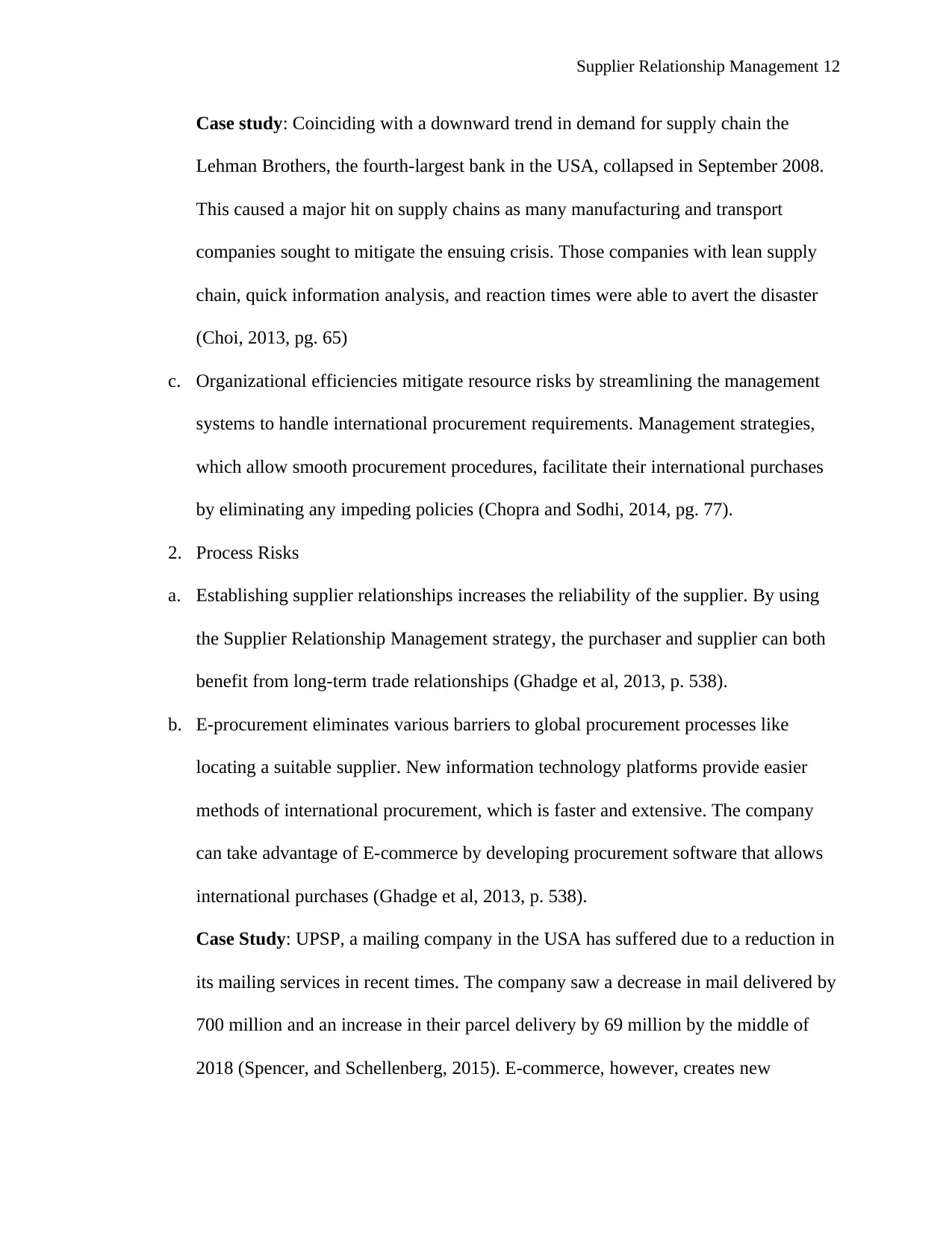
Supplier Relationship Management 12
Case study: Coinciding with a downward trend in demand for supply chain the
Lehman Brothers, the fourth-largest bank in the USA, collapsed in September 2008.
This caused a major hit on supply chains as many manufacturing and transport
companies sought to mitigate the ensuing crisis. Those companies with lean supply
chain, quick information analysis, and reaction times were able to avert the disaster
(Choi, 2013, pg. 65)
c. Organizational efficiencies mitigate resource risks by streamlining the management
systems to handle international procurement requirements. Management strategies,
which allow smooth procurement procedures, facilitate their international purchases
by eliminating any impeding policies (Chopra and Sodhi, 2014, pg. 77).
2. Process Risks
a. Establishing supplier relationships increases the reliability of the supplier. By using
the Supplier Relationship Management strategy, the purchaser and supplier can both
benefit from long-term trade relationships (Ghadge et al, 2013, p. 538).
b. E-procurement eliminates various barriers to global procurement processes like
locating a suitable supplier. New information technology platforms provide easier
methods of international procurement, which is faster and extensive. The company
can take advantage of E-commerce by developing procurement software that allows
international purchases (Ghadge et al, 2013, p. 538).
Case Study: UPSP, a mailing company in the USA has suffered due to a reduction in
its mailing services in recent times. The company saw a decrease in mail delivered by
700 million and an increase in their parcel delivery by 69 million by the middle of
2018 (Spencer, and Schellenberg, 2015). E-commerce, however, creates new
Case study: Coinciding with a downward trend in demand for supply chain the
Lehman Brothers, the fourth-largest bank in the USA, collapsed in September 2008.
This caused a major hit on supply chains as many manufacturing and transport
companies sought to mitigate the ensuing crisis. Those companies with lean supply
chain, quick information analysis, and reaction times were able to avert the disaster
(Choi, 2013, pg. 65)
c. Organizational efficiencies mitigate resource risks by streamlining the management
systems to handle international procurement requirements. Management strategies,
which allow smooth procurement procedures, facilitate their international purchases
by eliminating any impeding policies (Chopra and Sodhi, 2014, pg. 77).
2. Process Risks
a. Establishing supplier relationships increases the reliability of the supplier. By using
the Supplier Relationship Management strategy, the purchaser and supplier can both
benefit from long-term trade relationships (Ghadge et al, 2013, p. 538).
b. E-procurement eliminates various barriers to global procurement processes like
locating a suitable supplier. New information technology platforms provide easier
methods of international procurement, which is faster and extensive. The company
can take advantage of E-commerce by developing procurement software that allows
international purchases (Ghadge et al, 2013, p. 538).
Case Study: UPSP, a mailing company in the USA has suffered due to a reduction in
its mailing services in recent times. The company saw a decrease in mail delivered by
700 million and an increase in their parcel delivery by 69 million by the middle of
2018 (Spencer, and Schellenberg, 2015). E-commerce, however, creates new
⊘ This is a preview!⊘
Do you want full access?
Subscribe today to unlock all pages.

Trusted by 1+ million students worldwide
1 out of 17
Related Documents
Your All-in-One AI-Powered Toolkit for Academic Success.
+13062052269
info@desklib.com
Available 24*7 on WhatsApp / Email
![[object Object]](/_next/static/media/star-bottom.7253800d.svg)
Unlock your academic potential
Copyright © 2020–2025 A2Z Services. All Rights Reserved. Developed and managed by ZUCOL.





